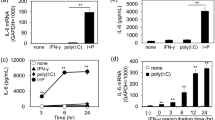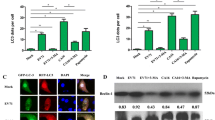Abstract
IL-36γ, a pro-inflammatory member of the IL-1 cytokine superfamily, can be induced and secreted by normal human foreskin keratinocytes (HFKs) in response to pathogenic stimuli, however, the mechanisms underlying the secretion are unknown. In this study, we demonstrate that stimulation with the TLR3 agonist, poly (I:C), led to a delayed secretion of IL-36γ compared to stimulation with the TLR5 agonist, flagellin, despite equal levels of the cytokine (p = 0.006). IL-36γ was shown to be released from HFKs in its inactive, uncleaved form, based on western blotting. Moreover, recombinant IL-36γ in its activated, cleaved form induced endogenous IL-36γ 10-fold (p = 0.004) and CXCL8 five-fold (p = 0.003) over baseline levels compared to unactivated full-length recombinant IL-36γ. The ratio of LC3b-II/LC3b-I was significantly higher in poly(I:C)-treated cells compared to flagellin-treated and unstimulated controls without a change in SQSTM1/p62 after 24 hours of stimulation (p = 0.043). Under fluorescence microscopy, poly(I:C) led to a two-fold increase at eight hours and four-fold increase at 24 hours in accumulated autophagosomes post-stimulation (p = 0.032). In contrast, autophagosomes were unchanged relative to baseline in response to flagellin. Bafilomycin A1 treatment enhanced poly(I:C)-mediated IL-36γ secretion (p = 0.044) while rapamycin led to a noticeable, but non-significant, increase in flagellin-mediated IL-36γ secretion, indicating that interrupting autophagic flux can alter IL-36γ release from HFKs. Finally, we show that, compared to clinically normal laryngeal tissue, there were significantly higher levels of LC3b-II in HPV-infected respiratory papilloma tissue, indicating a higher number of autophagosomes; a signature of disrupted autophagic flux.
Similar content being viewed by others
References
Chustz RT, Nagarkar DR, Poposki JA, et al. Regulation and function of the IL-1 family cytokine IL-1F9 in human bronchial epithelial cells. Am J Respir Cell Mol Biol 2011; 45: 145–53.
Traks T, Keermann M, Prans E, et al. Polymorphisms in IL36G gene are associated with plaque psoriasis. BMC Med Genet 2019; 20: 10.
Furue K, Yamamura K, Tsuji G, et al. Highlighting interleukin-36 signalling in plaque psoriasis and pustular psoriasis. Acta Derm Venereol 2018; 98: 5–13.
Satoh TK, Yamamura K, Tsuji G, et al. IL-36gamma drives skin toxicity induced by EGFR/MEK inhibition and commensal Cutibacterium acnes. J Clin Invest 2018; 130: 1417–30.
DeVoti JA, Rosenthal DW, Wu R, et al. Immune dysregulation and tumor-associated gene changes in recurrent respiratory papillomatosis: a paired microarray analysis. Mol Med 2008; 14: 608–17.
Clancy DM, Sullivan GP, Moran HBT, et al. Extracellular neutrophil proteases are efficient regulators of IL-1, IL-33, and IL-36 cytokine activity but poor effectors of microbial killing. Cell Rep 2018; 22: 2937–50.
Henry CM, Sullivan GP, Clancy DM, et al. Neutrophil-derived proteases escalate inflammation through activation of IL-36 family cytokines. Cell Rep 2016; 14: 708–22.
DeVoti J, Hatam L, Lucs A, et al. Decreased Langerhans cell responses to IL-36gamma: altered innate immunity in patients with recurrent respiratory papillomatosis. Mol Med 2014; 20: 372–80.
Lian LH, Milora KA, Manupipatpong KK, Jensen LE. The double-stranded RNA analogue polyinosinic-polycytidylic acid induces keratinocyte pyroptosis and release of IL-36gamma. J Invest Dermatol 2012; 132: 1346–53.
Rana AA, Lucs AV, DeVoti J, et al. Poly(I:C) induces controlled release of IL-36gamma from keratinocytes in the absence of cell death. Immunol Res 2015; 63: 228–35.
Wang J, Davis S, Zhu M, Miller EA, Ferro-Novick S. Autophagosome formation: where the secretory and autophagy pathways meet. Autophagy 2017; 13: 973–4.
Yu L, Chen Y, Tooze SA. Autophagy pathway: cellular and molecular mechanisms. Autophagy 2018; 14: 207–15.
Dupont N, Jiang S, Pilli M, et al. Autophagy-based unconventional secretory pathway for extracellular delivery of IL-1beta. EMBO J 2011; 30: 4701–11.
Chen YD, Fang Y-T, Cheng Y-L, et al. Exophagy of annexin A2 via RAB11, RAB8A and RAB27A in IFN-gamma-stimulated lung epithelial cells. Sci Rep 2017; 7: 5676.
Minakaki G, Menges S, Kittel A, et al. Autophagy inhibition promotes SNCA/alpha-synuclein release and transfer via extracellular vesicles with a hybrid autophagosome-exosome-like phenotype. Autophagy 2018; 14: 98–119.
Li X, He S, Ma B. Autophagy and autophagy-related proteins in cancer. Mol Cancer 2020; 19: 12.
Cassidy LD, Narita M. Cell biology. GATA get a hold on senescence. Science 2015; 349: 1448–9.
Darbro BW, Schneider GB, Klingelhutz AJ. Co-regulation of p16INK4A and migratory genes in culture conditions that lead to premature senescence in human keratinocytes. J Invest Dermatol 2005; 125: 499–509.
Towne JE, Renshaw BR, Douangpanya J, et al. Interleukin-36 (IL-36) ligands require processing for full agonist (IL-36alpha, IL-36beta, and IL-36gamma) or antagonist (IL-36Ra) activity. J Biol Chem 2011; 286: 42594–602.
Delgado MA, Elmaoued RA, Davis AS, Kyei G, Deretic V. Toll-like receptors control autophagy. EMBO J 2008; 27: 1110–21.
Yamamoto A, Tagawa Y, Yoshimori T, Moriyama Y, Masaki R, Tashiro Y. Bafilomycin A1 prevents maturation of autophagic vacuoles by inhibiting fusion between autophagosomes and lysosomes in rat hepatoma cell line, H-4-II-E cells. Cell Struct Funct 1998; 23: 3–42.
Yoshimori T, Yamamoto A, Moriyama Y, Futai M, Tashiro Y. Bafilomycin A1, a specific inhibitor of vacuolar-type H (+)-ATPase, inhibits acidification and protein degradation in lysosomes of cultured cells. J Biol Chem 1991; 266: 17707–12.
Kim YC, Guan KL. mTOR: a pharmacologic target for autophagy regulation. J Clin Invest 2015; 125: 25–32.
Chen X, Li M, Li L, et al. Trehalose, sucrose and raffinose are novel activators of autophagy in human keratinocytes through an mTOR-independent pathway. Sci Rep 2016; 6: 28423.
Jiang Z, Liu Y, Li C, et al. IL-36gamma Induced by the TLR3-SLUG-VDR Axis Promotes Wound Healing via REG3A. J Invest Dermatol 2017; 137: 2620–9.
D’Erme AM, Wilsmann-Theis D, Wagenpfeil J, et al. IL-36gamma (IL-1F9) is a biomarker for psoriasis skin lesions. J Invest Dermatol 2015; 135: 1025–32.
Zhang M, Kenny SJ, Ge L, Xu K, Schekman R. Translocation of interleukin-1beta into a vesicle intermediate in autophagy-mediated secretion. Elife 2015; 4: e11205.
Iula L, Keitelman IA, Sabbione F, et al. Autophagy mediates interleukin-1beta secretion in human neutrophils. Front Immunol 2018; 9: 269.
Papayannakos CJ, DeVoti JA, Israr M, et al. Extracellular vesicles produced by primary human keratinocytes in response to TLR agonists induce stimulus-specific responses in antigen-presenting cells. Cell Signal 2021; 83: 109994.
Guo J, Tu J, Hu Y, Song G, Yin Z. Cathepsin G cleaves and activates IL-36gamma and promotes the inflammation of psoriasis. Drug Des Devel Ther 2019; 13: 581–8.
Fu G, Gong D, Wan J. Human papillomavirus 16 E5 protein inhibits keratinocyte growth factor-triggered autophagy. Xi Bao Yu Fen Zi Mian Yi Xue Za Zhi 2016; 32: 1517–21.
Acknowledgments
We thank Dr. Michael R. Dores and the Hofstra University Biology Department for the use of some of their laboratory equipment.
Author information
Authors and Affiliations
Corresponding author
Additional information
Disclosure
Financial support: This work was supported in part by award number DE-017227 from the National Institute of Dental and Craniofacial Research, NIH, to VRB. Conflict of interest: The research was conducted in the absence of any commercial or financial relationships that could be construed as a potential conflict of interest. Dr. Bettie Steinberg serves on the Scientific Advisory Board of the RRP Foundation but receives no remuneration.
About this article
Cite this article
Papayannakos, C.J., Zhu, D., Jung, B. et al. Toll-like receptor agonists, poly(I:C) and flagellin, lead to IL-36γ induction with divergent release kinetics and differentially alter autophagy in primary human keratinocytes. Eur Cytokine Netw 33, 19–29 (2022). https://doi.org/10.1684/ecn.2022.0479
Published:
Issue Date:
DOI: https://doi.org/10.1684/ecn.2022.0479




